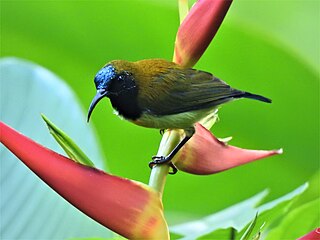
The blue-headed fantail is a fantail endemic to the northern Philippines where it is found on the islands of Luzon and Catanduanes. Until recently, it was considered conspecific with the Tablas fantail and Visayan fantail.

The flaming sunbird is a species of bird in the family Nectariniidae. It is endemic to the northern Philippines found on the islands of Luzon and Catanduanes. Its natural habitat is tropical moist lowland forests. It was formerly conspecific with the Maroon-naped sunbird.

The buzzing flowerpecker or white-bellied flowerpecker is a species of bird in the family Dicaeidae. It is endemic to the Philippines. Its natural habitats are tropical moist lowland forest and or tropical moist montane forest.

The pygmy flowerpecker is a species of bird in the family Dicaeidae. It is endemic to the Philippines.

The short-crested monarch is a species of bird in the family Monarchidae and one of the most attractive of all the monarch flycatchers. It is a brilliant ultramarine blue bird with the males having a black facial markings with an electric blue eyering and a short crest contrasted with a pearly white belly. It is endemic to the Philippines found on the islands of Luzon, Camiguin Norte, Polilio, Catanduanes, Samar, Dinagat and Mindanao. It is found in tropical moist lowland forest. It is threatened by habitat loss. Along with the Celestial monarch, It is one of the most sought after birds among birdwatchers.

The melodious babbler is a species of bird in the family Pellorneidae. It is endemic to the Philippines and found only on Palawan and Balabac.

The green-backed whistler or olive-backed whistler, is a species of bird in the family Pachycephalidae. It is endemic to the Philippines. Its natural habitats are tropical moist lowland forest and tropical moist montane forest.

The yellow-bellied whistler, or Philippine whistler, is a species of bird in the family Pachycephalidae that is endemic to the Philippines. Its natural habitats are tropical moist lowland forest and the lower reaches tropical moist montane forest.

The sulphur-billed nuthatch is a species of bird in the family Sittidae. It is endemic to the Philippines. Its natural habitats are tropical moist lowland forest and tropical moist montane forest. It is commonly found in mixed flocks along with Blue-headed fantails, sunbirds, flowerpeckers and other small forest birds.

The rusty-crowned babbler is a species of bird in the family Zosteropidae. It is native to the southern Philippines on the islands of Mindanao and Dinagat Islands and Basilan. Its natural habitat is tropical moist lowland forest.

The golden-crowned babbler is a species of bird in the family Zosteropidae. It is endemic to the Philippines found only in the moist tropical forest in Northern Luzon. It is threatened by habitat loss.

The Visayan babbler also known as the Visayan Black-crowned Babbler. is a species of bird in the family Zosteropidae. It is endemic to the Philippines. It is found on Samar, Leyte and Bohol. Its natural habitat is tropical moist lowland forest. It was formerly conspecific to the northern population of the Calabarzon black-crowned babbler but has since been split as a species due to differences in its yellowish throat and whiter belly.

The Negros striped babbler is a species of bird in the family Zosteropidae. It is endemic to Negros Island in the Philippines. Its natural habitat is tropical moist montane forest in the range of 900–1,600 masl. It is threatened by habitat loss.

The Mindanao pygmy babbler is a bird species endemic to the Philippines. It had been placed in the family Timaliidae, but it is a close relative of the white-eyes, however, and many taxonomists now place it in the family Zosteropidae..

The Luzon striped babbler is a species of bird in the family Zosteropidae. It is one of the four striped babblers along with the Negros striped babbler, Panay striped babbler and Palawan striped babbler. It is endemic to the Philippines, where it is only found in northern Luzon and in Bataan. Its natural habitat is tropical moist lowland forest. It is threatened by habitat loss.

Everett's white-eye is a bird species in the disputed family Zosteropidae, which might belong with the Old World babblers (Timaliidae). The name commemorates British colonial administrator and zoological collector Alfred Hart Everett. It is only found on the Talaud Islands, Sulu Archipelago and the Philippines. Its natural habitats are tropical moist lowland forests and tropical moist montane forests.

The lowland white-eye is a species of bird in the family Zosteropidae. It is near endemic to the northern part of the Philippines but is also found on the Taiwanese islands of Lüdao and Lanyu. Its natural habitat is tropical moist lowland forest, second growth and gardens.

The Negros leaf warbler is a songbird species from the leaf warbler family (Phylloscopidae). It was formerly included in the "Old World warbler" assemblage.

The Mindanao miniature babbler also known as the Mindanao plumed-warbler is a bird species in the family Cisticolidae. It was formerly conspecific with the Visayan miniature babbler. This bird is endemic to the Philippines found only on the island of Mindanao. Its natural habitats are tropical moist lowland forests and tropical moist montane forests. At just 7 centimeters long and weighing 5 grams, it is one of the smallest birds in Asia.

The Calabarzon babbler is a species of bird in the family Zosteropidae. It is endemic to the Philippines found in the island of Luzon. Contrary to its name, it is also found outside the Calabarzon region where it also inhabits Central Luzon, Bicol Peninsula and Catanduanes. Its natural habitat is tropical moist lowland forest. It previously was considered a subspecies of the black-crowned babbler.





















